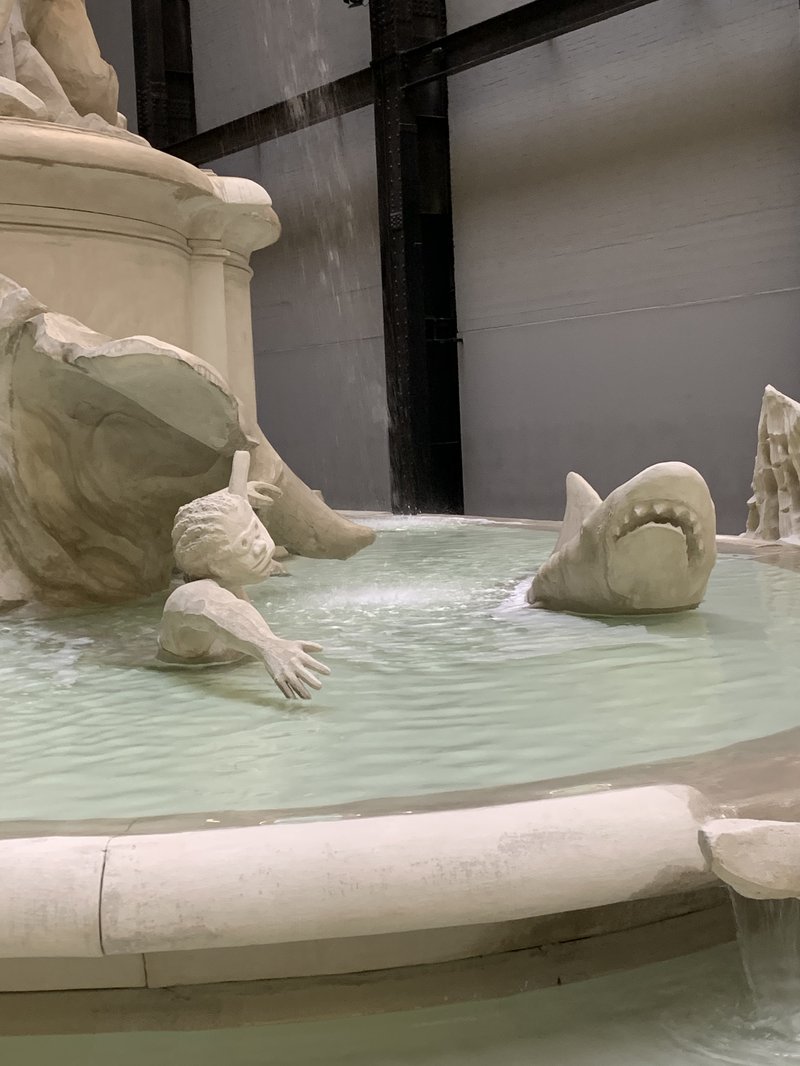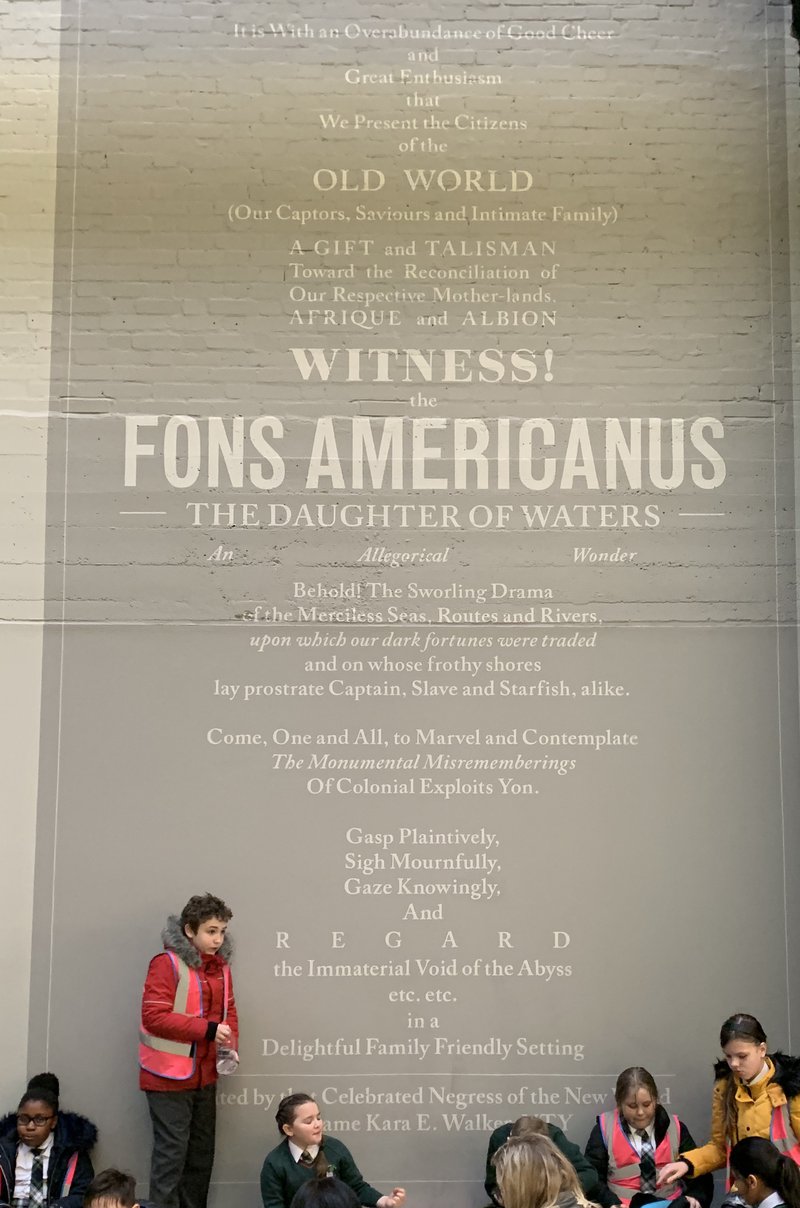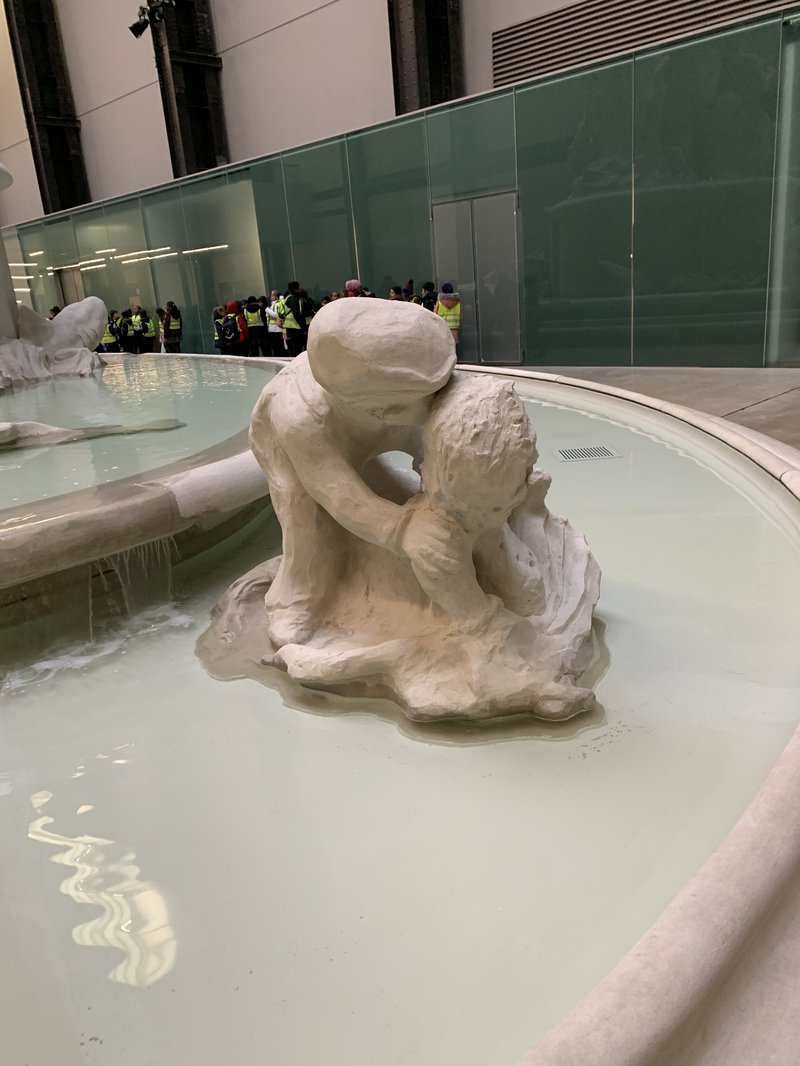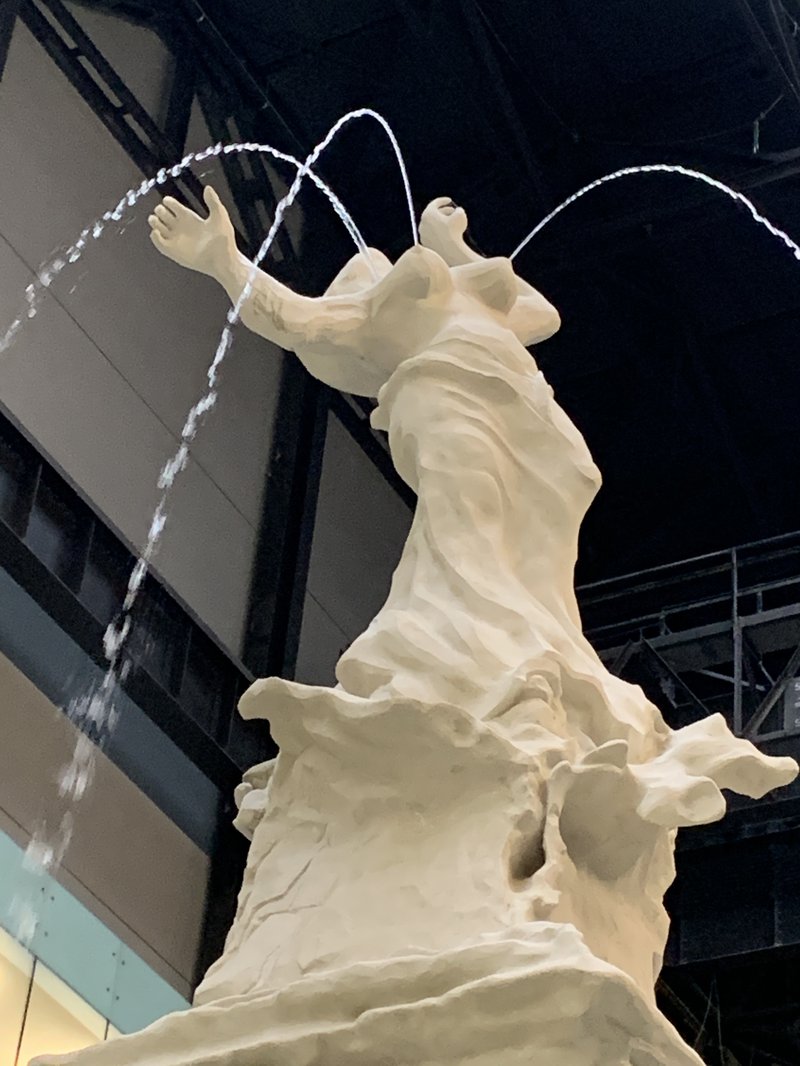
In the enormous space of the now depopulated Turbine Hall at Tate Modern a huge, three-tier take-off of the Victoria Monument rises towards the ceiling. The even more a colossal Victoria Monument itself dominates the focal point where the Mall meets Buckingham Palace at the centre of London. On its massive presence a solid, static Empress Victoria sits orb in hand staring down the Mall towards Westminster. Above her a golden winged victory celebrates her country and her reign. It’s a ghastly, artistically banal monument to imperial supremacy. Behind it, Buckingham Palace rests like a squat toad, devoid of architectural inspiration, thankfully kept behind bars. It is impossible to miss when driving past or walking in St James or Green Park. The earliest photographs I have of myself and my partner are black and white snaps that we took of each other within sight of the monument. Whenever I get near I avert my eyes; across a lifetime in London I have never stopped to look at it.
When I read that an American artist had mimicked it to create a work that demonstrated her opposition to slavery, it struck me she was projecting a truism onto a platitudinous tombstone of a decrepit order and I quickly turned the page. Later, I read Zadie Smith’s compelling essay on Kara Walker, ‘What do we want history to do to us?’, in the New York Review of Books. It introduced the artistic effort I had so thoughtlessly dismissed. So when, two weeks ago, I had an afternoon free and asked myself what exhibition would I most regret missing when the Coronavirus closes down the capital’s museums, I decided I had to see if Smith is right and Walker is indeed one of the defining artists of our time.
It was therefore with a sense of duty – of foreboding rather than anticipation – reinforced by rain endlessly pissing down, that I found myself walking onto the vast outside slope of the Turbine Hall. Head lowered, I expected only to find my country justifiably reprimanded.
Inside, the first thing that confronts you, facing up the slope, is a rendition of Botticelli’s huge shell cast in an energetic, cement-like material. In the 1480s Botticelli painted his famous Venus standing like a wistful sail on an enormous scallop shell, as if she were an improbable naked surfer being blown to shore. Here, the shell is vertical. It is like the one in Terry Gilliam’s The Adventures of Baron Munchausen that enclosed an 18 year old Uma Thurman or, as I learnt from the catalogue, in the 1800 engraving of a black Venus being taken by Neptune from Angola to the West Indies.
But Kara Walker’s great shell is empty. Or so it seems, until you approach it and witness an African head looking upwards trapped at the bottom. Perhaps drowning, perhaps buried, he is silently weeping, with large, distressed eyes full of tears that flow gently into the narrow space around his neck.
The replacement of the goddess of love, the emblem of opportunity, by a helpless, trapped young person, is heart-breaking. With tremendous confidence, it draws upon a familiar image of delight and turns it into tragedy. My sense of duty fell away, I was on a journey.
Coming under the viewing bridge to Kara Walker’s monument itself, the first thing that strikes you is that it is a fountain. Not just a dribbling one either. Water is gushing and bubbling from below and sailing up high into the air from the tits of a woman who is flinging open her arms at its pinnacle. Here is the missing Venus! Liberated from her mollusc she is no longer a docile, virginal personification and is erupting with womanly energy. Before you can take this in you realise that the whole assembly is full of life: sharks burst with amazing animation from the water, a young child with a snorkel and goggles swims for her life, a galleon ploughs through the water, its sails full of wind, an escaping man slumps across a small boat like a desperate migrant.
Because of its scale and energy photographs don’t convey the impact of what Kara Walker calls Fons Americanus. Fons is Latin for a fountain or spring and by giving it a species-like name she turns it into something larger and emblematic. The waters make it a monument to the ‘Black Atlantic’ that joins Europe, Africa and America. It overhauls the Statue of Liberty as much as Victoria’s Britannic monument. Each of them laud merely an achievement; Fons Americanus is a liquid memorial to the intercontinental process that made them both.

The use of language is integral to Fons Americanus. This does not diminish its artistic authority. For it is a monument not a sculpture and monuments always announce themselves with a narrative declaration of what they memorialise. Words are part of the work. Walker takes this and doubles it by means of an immense imitation of the proclamations of slave auctions and or fairground shows. She had it painted on the side of the Turbine Hall. It transforms the entire work into a gift.
It is with an Overabundance of Good Cheer And Great Enthusiasm that We Present to the Citizens of the Old World (Our Captors, Saviours and Intimate Family) A Gift and Talisman Toward the Reconciliation of Our Respective Mother-lands Afrique and Albion.
Witness!
The Fons Americanus – the Daughter of Waters – an Allegorical Wonder.
Behold! The swirling Drama of the Merciless Seas, Routes and Rivers, upon which our dark fortunes were traded and on whose frothy shores lay prostrate Captain, Slave and Starfish alike. Come, One and All, to Marvel and Contemplate. The Monumental Misrememberings of Colonial Exploits Yon.
Gasp Plaintively, Sigh Mournfully, Gaze Knowingly and REGARD the Immaterial Void of the Abyss etc. etc. in a Delightful Family Friendly Setting.
Created by that Celebrated Negress of the New World Madame Kara E Walker, NTY

Who is Kara Walker to presume she can make us such a gift, not as a humble offering but as an act of reconciliation of “our” respective motherlands? In her brief, catalogue presentation, Walker mentions that thanks to James Thorpe she has “English blood coursing through my African-American veins”. He fathered a ‘Negro’ son in Reconstruction-era South Carolina. It means she herself embodies all three continents. Among other things she is one of us: us being white English children of Albion. We all know that generations of agony and humiliation followed on from the genocidal conveyance of those who were enslaved to grow and harvest our sugar. Yet on behalf of all of us, descendants of the enslavers as well as the enslaved, Walker simultaneously proclaims that this appalling history happened and celebrates the fact that here we are now, together and alive. Fons Americanus is offered to us as act of joy; a reconciliation to replace the divisions, racism and misanthropy of the Age of Trump and Brexit.
One of the ways Walker achieves this is through the figures on and within her fountain. Marina Warner’s Monuments and Maidens is a classic study of the allegorical sculptures that populate the historic buildings and squares of Europe and America. She shows us how, by deploying their idealised purity, curvaceous women in breast-slipping negligées or revealing gowns are utilised to personify imperial virtues such as courage, wisdom, justice, liberty, fortitude, truth, charity, victory, even immortality, and of course Britannia. A glorification of the feminine form cemented to a pedestal expresses the presumption of a male order that seeks to inscribe its hegemony as natural. The Victoria monument is a towering example.

Walker literally deconstructs these monumental tropes and their pretention to sculptural art by replacing them with rough looking images of actual narratives. First, their appearance simulates the hand-hewn modelling of clay (as Cora Gilroy-Ware describes) discarding any pretention to eternal smoothness. Second, the figures are almost all based on stories, or images of stories that allude to familiar or, for me, half-forgotten works of art. On the front of the middle tier is a black emperor, looking like Toussaint L’Ouverture imitating Napoleon, or those who mimicked him doing so. To his right an angel in the form of the hanging tree that swung Billie Holliday’s strange fruit. Below them is what Walker calls the Pietà of Emmett Till, the 14 year old whose innocent, shot and mutilated body was lifted from the Tallahatchie River in Mississippi in 1955.
In this way Walker makes the fountain a monument to the reality of the imperial epoch. Instead of allegorical figures that seek to eternalise the sentiments of supremacy hers ask us to regard our own emotional reactions: this really happened.
With two exceptions. At the back of the monument is what Walker calls its “Queen Vicky”. Where the vast memorial on the Mall has an actual person, Fons Americanus gives us an allegory. With a huge arse and a glorious headdress, she carries a coconut in place of an orb, a “symbol of life, ego, sustainance, commerce, and death if it falls on your head”. And at the top, instead of a winged victory, there is Venus. No longer a coy pagan pinup but a rollicking Yoruba daughter of the waters from whose nipples rocket the milk of future life.

Which is why Kara Walker’s fully human celebration is such a gift. The reconciliation she offers us, and which we should accept wholeheartedly, is not a sombre restorative reckoning but a celebration of truthfulness.
Back in 2005, Gordon Brown wanted to position himself to succeed Tony Blair and said on a visit to Tanzania, “The days of Britain having to apologise for its colonial history are over. We should move forward… We should celebrate much of our past rather than apologise for it”. Shortly after, at a Fabian Conference where Brown expanded his views on Britishness, Paul Gilroy dryly inquired as to when, if Britain should now stop apologising for its colonial history, did it begin to do so?
It’s a fair point and Brown makes much of how ‘fairness’ is core British value. But Kara Walker takes us to a different place. She demonstrates that we can begin to put the Black Atlantic behind us provided we witness our misremembering, cast aside the white-washing, memorialise the mis-deeds, rage at the reality and then enjoy the fountain of love. Instead of criticism and condemnation she gives us something else. A high energy refusal of denial. Implicitly, this brushes aside any attempt, such as Brown’s, that seeks to replace the bad with the good. Both are inextricably part of us, our inheritance and, alas, our legacy. Out of the wreckage and in high spirits, Walker brings us our shared humanity, here and now and across all waters.
How should we in England respond to this heavenly gift? When the gilded, winged victory on the Victoria Monument was unveiled in 1911, its sculptor, Thomas Brock, “was knighted on the spot by a delighted George V”. In our plague ridden times of social distancing we can send Kara Walker a virtual embrace of thanks via the world wide web. And I do. But how can the country accept this astonishing reworking of Atlantic relations? A gift creates an ongoing but non-financial relationship; it calls for reciprocity. At the very least this means Fons Americanus should be accepted and given a public place. Without a government capable of any such emotional intelligence it is the glorious responsibility of the Mayor of London and the directors of Tate Modern to find Fons Americanus a permanent home.